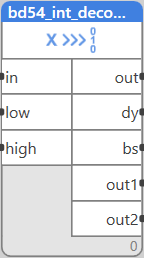Integer decomposition

Block name
BD54_INT_DECOMPOSITION
ST call
PROGRAM BD54
VAR
ARRAY1: ARRAY [0..3] OF DINT;
ARRAY2: ARRAY [0..3] OF REAL;
DINT1: DINT := 23139;
FB: LIB.CORE.V1_0.BD54_INT_DECOMPOSITION := (LOW := [1, 5, 1, 13] ,HIGH := [4, 8, 8, 16]);
END_VAR
FB(IN:= DINT1, OUT=>ARRAY1, DY=>ARRAY2);
END_PROGRAM
Library
LIB\CORE
Version
V1.0
Description
The block decomposes the input data to up to four (integer) values composed from defined range of bits.
Inputs
| Input | Type | Description | Default value |
| IN | DINT | Input data - double integer value | 0 |
| LOW | ARRAY[0..3] OF LIB.CORE.V1_0.BIT32 | first bits of the range, array [0..3] with values 1 to 32 | [1] |
| HIGH | ARRAY[0..3] OF LIB.CORE.V1_0.BIT32 | last bits of the range, array [0..3] with values 1 to 32 | [1] |
Outputs
| Output | Type | Description |
|---|---|---|
| OUT | ARRAY_DINT | Output value, array [0..3] |
| DY | ARRAY_REAL | Output value, array [0..3] |
| bs | bool | Sign of the input value |
Function
The block decomposes the input data according to the low and high parameters. For example, to evaluate the first 4 bits as a value ranged from 0 to 15, fill in low as [1,0,0,0] and high as [4,0,0,0]: the low bit is 1, the high bit is 4. The resulting value will be in the first element of the output array. bs is the sign of the input data. The displayed range may be 2 to 32 bits.
Application example

Input vector decomposition with parameters low = [1,5,1,13] and high = [4,8,8,16]. The first value is composed from bits 1 to 4, the second value is composed from bits 5 to 8, third value from bits 1 to 8, and fourth value from bits 13 to 16 of the input value dint1.